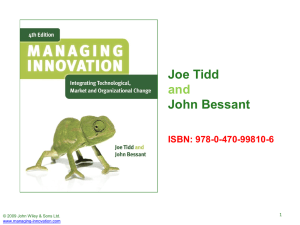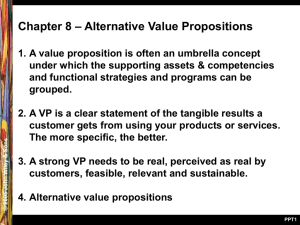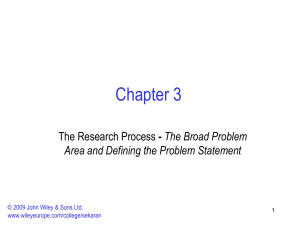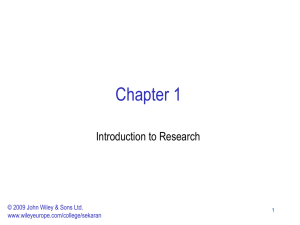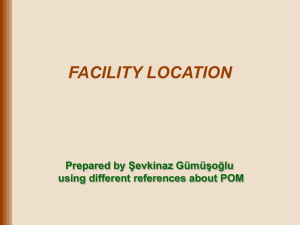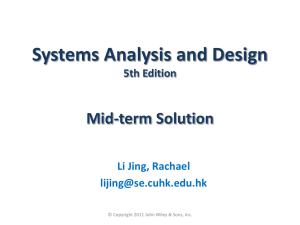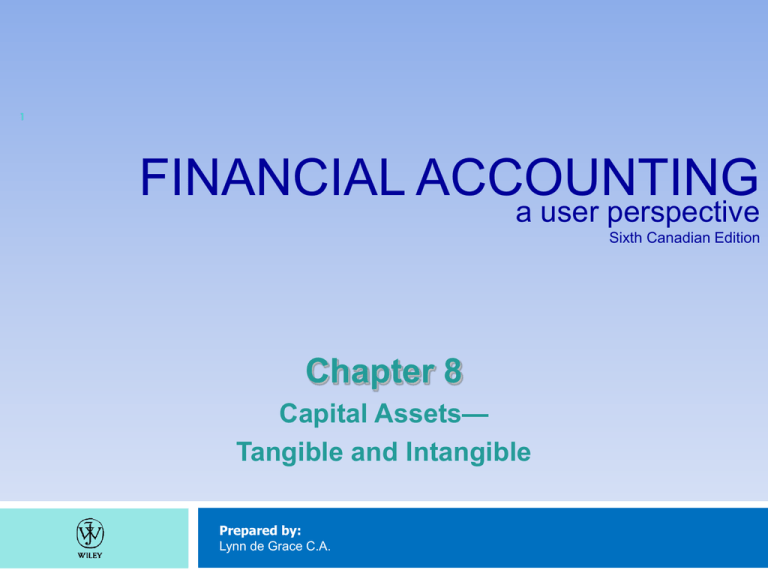
1
FINANCIAL ACCOUNTING
a user perspective
Sixth Canadian Edition
Chapter 8
Capital Assets—
Tangible and Intangible
Prepared by:
Lynn de Grace C.A.
Capital Assets— Recognition
2
A capital asset
Has value in use
•
•
Used to generate future revenue through sales of products or
services
Cash received over several future periods
Used until replaced with a new asset
•
Can have residual (or resale) value
John Wiley & Sons Canada, Ltd. ©2011
Valuation of Capital Assets
3
Alternative 1 – Historical cost
Original cost of the asset
Expensed (amortized) over the useful life
Gain or loss on sale
•
•
Recognized only when sold
Difference between the proceeds of the sale and the net book
value
Net book value (or carrying value)
•
•
Original cost less amortization
Also called the amortized cost of the asset
John Wiley & Sons Canada, Ltd. ©2011
Valuation of Capital Assets
Alternative 2: Market Value—Replacement Cost
Amount that would be needed to acquire an equivalent asset
Unrealized gains and losses are recognized as the
replacement value of the asset changes
Amortization would need to be adjusted each time the
replacement value changes
John Wiley & Sons Canada, Ltd. ©2011
4
Valuation of Capital Assets
Alternative 3: Market Value—NRV
Amount that would be received by converting the asset to
cash
Unrealized gains and losses are recognized as NRV
changes
Amortization is adjusted each time NRV is adjusted
When the asset is sold or disposed of, the gain or loss will
be small
John Wiley & Sons Canada, Ltd. ©2011
5
Valuation of Capital Assets
6
Canadian practice:
Use historical cost (original acquisition cost). Meets objectives:
reliable, verifiable, objective
Amortize cost over the period of use
Market value changes are not recognized until the asset is
disposed of.
IFRS:
•
•
Companies may opt to use NRV to value capital assets
Unrealized gains and losses are reported directly in shareholders’
equity as a revaluation reserve.
John Wiley & Sons Canada, Ltd. ©2011
Capitalizable Costs
7
Costs to acquire and prepare the asset for use
•
•
•
•
•
•
Purchase price (less any discounts)
Transportation costs
Preparation, installation and set-up costs
Direct taxes
Interest costs (on self-constructed assets)
Legal costs associated with the purchase
John Wiley & Sons Canada, Ltd. ©2011
Basket Purchases
8
Several assets acquired in one transaction
Price paid is divided between the assets on the basis of
their relative fair values at the time of acquisition
John Wiley & Sons Canada, Ltd. ©2011
Basket Purchases
9
Timberland Example
Asset
Land
Timber
Fair Values
% of fair
value
Purchase Price
Allocation
250,000
25%
$220,000
750,000
75%
660,000
$1,000,000
100%
$ 880,000
$
John Wiley & Sons Canada, Ltd. ©2011
Interest Capitalization
10
Companies often borrow money to finance
•
•
A capital asset
The construction of a capital asset
IFRS - Interest paid on borrowed money may be capitalized
for assets constructed or acquired over time.
John Wiley & Sons Canada, Ltd. ©2011
Amortization Concepts
11
Systematic and rational method of allocating the cost of
capital assets to the periods in which the benefits from the
assets are received (the useful life)
Does not refer to the value of the asset
Respects the matching concept
John Wiley & Sons Canada, Ltd. ©2011
Amortization Methods
12
Straight-line method
Production method
Accelerated or declining-balance method
Decelerated or compound interest method
John Wiley & Sons Canada, Ltd. ©2011
Straight-Line Method
13
Allocates the cost evenly over the life of the asset
Estimates needed for:
•
•
Useful life
Residual value
Advantage is simplicity
John Wiley & Sons Canada, Ltd. ©2011
Straight-Line Method
14
EXAMPLE – Data/Assumptions:
•
•
Original cost
Estimated
•
•
$50,000
Residual value
Useful life
$5,000
5 years
John Wiley & Sons Canada, Ltd. ©2011
Straight-Line Method
15
Amortization
=
Expense
=
Original Cost - Estimated
Residual Value
Estimated Useful Life
$50,000 - $5,000
5 years
= $9,000 per year
John Wiley & Sons Canada, Ltd. ©2011
Straight-Line Method
16
Amortization Schedule
Year
1
2
3
4
5
Beg. Book
Value
$50,000
41,000
32,000
23,000
14,000
Amortization Ending Book
Expense
Value
$9,000
$41,000
9,000
32,000
9,000
23,000
9,000
14,000
9,000
5,000
$45,000
John Wiley & Sons Canada, Ltd. ©2011
Units of Production Method
17
Assumptions
• Benefits derived are related to the output or use
of an asset
Requires that the useful life can be expressed as
units of output
John Wiley & Sons Canada, Ltd. ©2011
Units of Production Method
18
Data/Assumptions:
• Original cost
$50,000
• Estimated
• Residual value
$5,000
• Usage:
Year 1
4,000 units
Year 2
5,000 units
Year 3
6,000 units
Year 4
4,500 units
Year 5
3,000 units
22,500 units
John Wiley & Sons Canada, Ltd. ©2011
Units of Production Method
19
Amortization
Expense per =
Unit
=
Cost - Residual Value
Estimated Total Units of
Output
$50,000 - $5,000
22,500 units
=
$2.00 per unit
John Wiley & Sons Canada, Ltd. ©2011
Units of Production Method
20
Amortization Schedule
Year
1
2
3
4
5
Cost per
Unit
$2.00
2.00
2.00
2.00
2.00
Units Amortization Ending NBV
Produced
Expense
$4,000
5,000
6,000
4,500
3,000
$8,000
10,000
12,000
9,000
6,000
$45,000
John Wiley & Sons Canada, Ltd. ©2011
$42,000
32,000
20,000
11,000
5,000
Accelerated Depreciation Methods
21
Amortization
•
Multiply the carrying value of the asset by a fixed percentage
Carrying value decreases each year
Amortization expense decreases each year
John Wiley & Sons Canada, Ltd. ©2011
Accelerated Depreciation Methods
22
Percentage rates
• Lower when asset has longer life
Double-declining-balance method
• Percentage is double the straight-line rate
• Residual value
• Not used for calculations
• Serves as a constraint
Formula
• (Cost – Accumulated Amortization at beginning of
period) X Amortization % = Amortization Expense
John Wiley & Sons Canada, Ltd. ©2011
Double Declining Balance Method
23
Data:
•
•
•
Original cost
Estimated Residual value
Estimated Useful life
$50,000
$5,000
5 years
Rate Calculation:
DDB rate = DB% x SL rate
John Wiley & Sons Canada, Ltd. ©2011
= 2 x 1/n yrs
= 2 x 1/5yrs
= 40%
Double-Declining- Balance Method
24
Amortization Schedule
Amortization
Expense
$20,000
Ending NBV
1
Beginning
NBV
$50,000
2
30,000
12,000
18,000
3
18,000
7,200
10,800
4
10,800
4,320
6,480
5
6,480
1,480
5,000
Year
John Wiley & Sons Canada, Ltd. ©2011
$30,000
Recording Amortization Expense
25
The same journal entry is used for all amortization
methods:
Amortization expense (SE)
XX
Accumulated amortization (XA) XX
Use of a contra-asset account—more informative
than reducing the asset directly.
John Wiley & Sons Canada, Ltd. ©2011
Corporate Income Taxes
26
Canada Revenue Agency (CRA)
• Amortization expense is allowed to be
deducted to calculate accounting income
• Capital cost allowance (CCA) instead must be
used to calculate taxable income
John Wiley & Sons Canada, Ltd. ©2011
Corporate Income Taxes
27
Must add back amortization expense to net income
and deduct CCA instead.
Results in a temporary difference between
accounting income and taxable income
Result is a future income tax liability or asset
(Amortization Expense – CCA) x Tax Rate = Future Income Tax
Asset/Liability
John Wiley & Sons Canada, Ltd. ©2011
Capital Cost Allowance (CCA)
28
Capital assets are grouped into classes and
assigned a maximum rate
Example:
Vehicles: Class 10 - rate 30 %
Equipment: Class 8 - rate 20 %
Most classes are declining balance
John Wiley & Sons Canada, Ltd. ©2011
Capital Cost Allowance (CCA)
29
Company purchases new equipment (Class 8) costing
$50,000
CCA calculation:
Year
Rate
UCC
CCA
(Cost-Accumulated CCA)
1
20% x
50,000 x 50%
= 5,000
2
20% x
(50,000 - 5,000)
= 9,000
3
20% x
(50,000 - 14,000)
= 7,200
4
20% x
(50,000 - 21,200)
= 5,760
John Wiley & Sons Canada, Ltd. ©2011
Future Income Taxes
Accounting Taxable Income
Income
Revenues
Amortization
CCA
Other Expenses
Income Before Tax
Taxes at 40%
$100,000
$100,000
(9,000)
—
—
(5,000)
(66,000)
(66,000)
25,000
29,000
$10,000
$11,600
John Wiley & Sons Canada, Ltd. ©2011
30
Future Income Taxes
31
Journal entry:
Income Tax expense (SE)
Future tax asset (A)
Income taxes payable (L)
10,000
1,600
*(Future tax liability if a credit balance)
John Wiley & Sons Canada, Ltd. ©2011
11,600
Changes in Depreciation Estimates
32
Estimates of useful life and residual value may change
over time - amortization may change as a result.
Example: Data/assumptions
•
•
•
•
Original cost
Estimated
• Residual value
• Useful life
Straight-line amortization
NBV at end of year 3
John Wiley & Sons Canada, Ltd. ©2011
$50,000
$5,000
5 years
$9,000
$23,000
Changes in Amortization Estimates
33
Change in year 4
Residual value
Remaining useful life
Amortization
Expense
=
=
=
$2,000
3 years
Remaining Book Value
– Residual Value
Useful Life
$23,000 – $2,000
3 years
$7000 per year for years
4, 5, and 6
John Wiley & Sons Canada, Ltd. ©2011
Write-down of Capital Assets
34
Net Recoverable Amount
The total of all the future cash flows related to the asset,
without discounting them to present values.
If an asset’s carrying value exceeds its net recoverable
amount, the carrying value must be written down and the
difference recognized as an impairment loss.
Under both historical cost and net realizable value, an asset
cannot be valued at more than the amount that can be
recovered from it.
John Wiley & Sons Canada, Ltd. ©2011
Write-down of Capital Assets
35
If future recoverable amount of a capital asset declines
below its carrying value
Loss due to damage to equipment (SE) 3,000
Accumulated depreciation (XA)
3,000
John Wiley & Sons Canada, Ltd. ©2011
Sale of Capital Assets
36
Original cost and accumulated amortization removed from
accounts
Gain or loss: difference between cash received and book
value of asset
Cash (A)
Accumulated amortization (XA)
Equipment (A)
Gain on sale of equipment (SE)
6,000
45,000
John Wiley & Sons Canada, Ltd. ©2011
50,000
1,000
Disposal of Capital Assets
37
If assets are disposed of and no cash is received:
Accumulated amortization (XA)
Loss on disposal of equipment (SE)
Equipment (A)
45,000
5,000
John Wiley & Sons Canada, Ltd. ©2011
50,000
Capital Asset Disclosures
38
John Wiley & Sons Canada, Ltd. ©2011
Natural Resources
39
Capitalizing the costs as assets implies that they have future
value
Example: oil exploration
Exploration costs methods
• Full costing method – capitalizes the costs of all
explorations, both successful and unsuccessful, as long as the
expected revenues from all the explorations are estimated
to exceed the total costs.
Successful efforts method – capitalizes only the cost of
successful explorations and expenses any unsuccessful
exploration costs.
Amortization of natural resources is called depletion
John Wiley & Sons Canada, Ltd. ©2011
Intangible Assets
40
Intangible assets have probable future value but may not
have physical form
Guidelines:
• If developed internally, expense costs as incurred
• If purchased, acquisition costs can be capitalized
John Wiley & Sons Canada, Ltd. ©2011
Intangible Assets - Amortization
41
Estimate useful life and residual value (if any)
Straight-line method is most commonly used
Accumulated amortization account rarely used
Amortization expense (SE)
Patents (A)
XX
John Wiley & Sons Canada, Ltd. ©2011
XX
Intangible Assets
42
Advertising
• Generally expensed as incurred
• Difficult to justify future benefits
Patents, Trademarks, Copyrights
• Legal life is the maximum for amortizing
• Useful, or economic life, is generally used for calculating
amortization
Goodwill
• Capitalize if purchased but not amortized
• Annual evaluation to determine if value is impaired—if so,
write-down is required
John Wiley & Sons Canada, Ltd. ©2011
Return on Assets
43
Widely used to assess how well management has used the
assets to operate income
Interest expense is added back to income to equate interest
with dividends
Interest expense is adjusted to reflect the fact that it is taxdeductible
What does
“tax deductible” mean?
John Wiley & Sons Canada, Ltd. ©2011
43
Return on Assets
ROA
=
=
Income before Interest expense
Average total assets
Net income + [Interest expense - Tax savings of
Interest Expense)]
Average total assets
=
Net Income + [Interest Expense X (1 – Tax Rate)]
Average total assets
John Wiley & Sons Canada, Ltd. ©2011
Statement Analysis Considerations
Choice of amortization method affects both the value of asset
on balance sheet and the amount of expense on the income
statement;
Many valuable assets are not recorded on the balance sheet
because they are internally developed, e.g., customer lists,
intellectual property, human resources;
Establishing the market values for some assets might be
relevant if the company has to replace them;
Soft assets, such as development costs, may require skepticism.
What is a “soft asset” ?
John Wiley & Sons Canada, Ltd. ©2011
45
Copyright
46
Copyright © 2011 John Wiley & Sons Canada, Ltd. All rights reserved.
Reproduction or translation of this work beyond that permitted by Access
Copyright (The Canadian Copyright Licensing Agency) is unlawful. Request
for further information should be addressed to the Permissions Department,
John Wiley & Sons Canada, Ltd. The purchaser may make back-up copies
for his / her own use only and not for distribution or resale. The author and
the publisher assume no responsibility for errors, omissions, or damages,
caused by the use of these programs or from the use of the information
contained herein.


